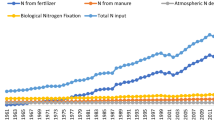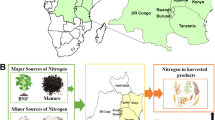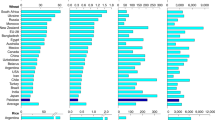Abstract
Nitrogen use efficiency (NUE) in crop production, the proportion of applied nitrogen (N) removed by the harvested yield of crops, dictates food security, loss of N to the environment, and efforts to curb climate change due to N2O emissions. Monitoring and maintaining high NUE assumes great importance in India because it is the second-largest consumer of fertilizer N in the world. Based on N input and N output data from 1961 to 2018 available at the Soil Nutrient Budget domain of the FAOSTAT database for different countries, trends in NUE, N output in harvested yield, and surplus N in India were compared with those in North America and the global average. The proportion of fertilizer N in the total N input for crop production in India is increasing since the advent of the Green Revolution in the mid-1960s, but NUE has declined from 48 to 35% in 2018; NUE in North America was 58% in 1961 and 53% in 2018. Substantially less maximum yield under saturating N input regimes, as well as N-based yield gap in India as compared to in North America or the world, suggest that there is a limited scope of achieving substantial yield gains in India by applying more fertilizer N. Although the maximum yield under saturating N input regimes based on the period 2010 to 2018 has increased than when based on 1961 to 2009, farmers in India need to greatly improve crop and fertilizer N management in terms of adopting technological innovations and avoiding N application more than the need of the crops to achieve NUE closer to that observed in North America. Adoption of site-specific N management strategies hold great potential but adoption of technologically advanced N options such as controlled release N fertilizers, and nitrification and urease inhibitors will depend upon benefit: cost ratio of their use in India.








Similar content being viewed by others
References
Bhatt R, Singh M (2021) Comparative efficiency of polymer-coated urea for lowland rice in semi-arid tropics. Commun Soil Sci Plant Anal 52:2331–2341. https://doi.org/10.1080/00103624.2021.1925689
Bijay-Singh, Singh VK (2017) Advances in nutrient management in rice cultivation. In: Sasaki T (ed) Achieving sustainable cultivation of rice, vol 2. Burleigh Dodds Science Publishing Limited, Cambridge, pp 25–68. https://doi.org/10.19103/AS.2016.0003.16
Bijay-Singh, Craswell E (2021) Fertilizers and nitrate pollution of surface and ground water: An increasingly pervasive global problem. SN Appl Sci 3:518. https://doi.org/10.1007/s42452-021-04521-8
Bijay-Singh, Varinderpal-Singh, Ali AM (2020) Site-specific fertilizer nitrogen management in cereals in South Asia. Sustain Agric Rev 39:137–178. https://doi.org/10.1007/978-3-030-38881-2_6
Bijay-Singh, Varinderpal-Singh, Purba J, Sharma RK, Jat ML, Yadvinder-Singh, Thind HS, Gupta RK, Choudhary OP, Chandna P, Khurana HS, Kumar A, Jagmohan-Singh, Uppal, HS, Uppal RK, Vashistha M, Gupta RK (2015) Site-specific nitrogen management in irrigated transplanted rice (Oryza sativa) using an optical sensor. Precis Agric 16:455–475. https://doi.org/10.1007/s11119-015-9389-6
Bijay-Singh, Varinderpal-Singh, Yadvinder-Singh, Thind HS, Kumar A, Choudhary OP, Gupta RK, Vashistha M (2017) Site-specific fertilizer nitrogen management using optical sensor in irrigated wheat in the North-Western India. Agric Res 6:159–168. https://doi.org/10.1007/s40003-017-0251-0
Bijay-Singh, Varinderpal-Singh, Yadvinder-Singh, Ajay-Kumar, Sharma S, Thind HS, Choudhary OP, Vashistha M (2018) Site-specific fertilizer nitrogen management in irrigated wheat using chlorophyll meter (SPAD meter) in the North-Western India. J Indian Soc Soil Sci 66:53–65. https://doi.org/10.5958/0974-0228.2018.00006.3
Bodirsky BL, Müller C (2014) Robust relationship between yields and nitrogen inputs indicates three ways to reduce nitrogen pollution. Environ Res Lett 9:111005. https://doi.org/10.1088/1748-9326/9/11/111005
Bora K (2022) Spatial patterns of fertilizer use and imbalances: Evidence from rice cultivation in India. Environ Chall 7:100452. https://doi.org/10.1016/j.envc.2022.100452
Cela S, Ketterings QM, Soberon MA, Rasmussen CN, Czymmek KJ (2017) Upper Susquehanna watershed and New York State improvements in nitrogen and phosphorus mass balances of dairy farms. J Soil Water Conserv 72:1–11. https://doi.org/10.2489/jswc.72.1.1
Chien SH, Prochnow LI, Cantarella AH (2009) Recent developments of fertilizer production and use to improve nutrient efficiency and minimize environmental impacts. Adv Agron 102:267–322. https://doi.org/10.1016/S0065-2113(09)01008-6
Conant RT, Berdanier AB, Grace PR (2013) Patterns and trends in nitrogen use and nitrogen recovery efficiency in world agriculture. Glob Biogeochem Cycl 27:558–566. https://doi.org/10.1002/gbc.20053
Davidson EA, Suddick EC, Rice CW, Prokopy LS (2015) More food, low pollution (Mo Fo Lo Po): A grand challenge for the 21st century. J Environ Qual 44:305–311. https://doi.org/10.2134/jeq2015.02.0078
Dourado-Neto D, Powlson D, Abu Bakar R, Bacchi OOS, Basanta MV, thi Cong P, Keerthisinghe G, Ismaili M, Rahman SM, Reichardt K, Safwat MSA, Sangakkara R, Timm LC, Wang JY, Zagal E, van Kessel C (2010) Multiseason recoveries of organic and inorganic nitrogen-15 in tropical cropping systems. Soil Sci Soc Am J 74:139–152. https://doi.org/10.2136/sssaj2009.0192
Fowler D, Pyle JA, Raven JA, Sutton MA (2013) The global nitrogen cycle in the twenty-first century. Philos Trans R Soc B 368:20130165. https://doi.org/10.1098/rstb.2013.0165
Gardner JB, Drinkwater LE (2009) The fate of nitrogen in grain cropping systems: a meta-analysis of 15N field experiments. Ecol Appl 19:2167–2184. https://doi.org/10.1890/08-1122.1
Heffer P, Gruère A, Roberts T (2017) Assessment of fertilizer use by crop at the global level 2014–2014/15. International Fertilizer Association (IFA), Paris, France, and International Plant Nutrition Institute (IPNI). Report A/17/134 rev, pp 18.
Houlton BZ, Almaraz M, Aneja V, Austin AT, Bai E, Cassman KG, Compton JE, Davidson EA, Erisman JW, Galloway JN, Gu B (2019) A world of co-benefits: Solving the global nitrogen challenge. Earth’s Future 7:865–872. https://doi.org/10.1029/2019EF001222
Huddell AM, Galford GL, Tully KL, Crowley C, Palm CA, Neill C, Hickman JE, Menge DN (2020) Meta-analysis on the potential for increasing nitrogen losses from intensifying tropical agriculture. Glob Change Biol 26:1668–1680. https://doi.org/10.1111/gcb.14951
Jat ML, Bijay-Singh, Gerard B (2014) Nutrient management and use efficiency in wheat systems of South Asia. Adv Agron 125:171–259. https://doi.org/10.1016/B978-0-12-800137-0.00005-4
Jena D, Misra C, Bandyopadhyay KK (2003) Effect of prilled urea and urea super granules on dynamics of ammonia volatilisation and nitrogen use efficiency of rice. J Indian Soc Soil Sci 51:257–261
Katyal JC, Bijay-Singh, Vlek PLG, Buresh RJ (1987) Efficient nitrogen use as affected by urea application and irrigation sequence. Soil Sci Soc Am J 51:366–370. https://doi.org/10.2136/sssaj1987.03615995005100020020x
Khurana HS, Phillips SB, Bijay-Singh, Alley MM, Dobermann A, Sidhu AS, Yadvinder-Singh, Peng S (2008) Agronomic and economic evaluation of site-specific nutrient management for irrigated wheat in Northwest India. Nutr Cycl Agroecosyst 82:15–31. https://doi.org/10.1007/s10705-008-9166-2
Kondo M, Singh CV, Agbisit R, Murty MVR (2005) Yield response to urea and controlled-release urea as affected by water supply in tropical upland rice. J Plant Nutr 28:201–219. https://doi.org/10.1081/PLN-200047601
Kulkarni RV, Marathe AB, Ingavale MT, Patil AP (2005) Effect of nitrogen application through prilled urea and urea super granules on drilled rainfed rice. J Soils Crops 15:102–104
Kumar D, Patel RA, Ramani VP, Rathod SV (2021) Evaluating precision nitrogen management practices in terms of yield, nitrogen use efficiency and nitrogen loss reduction in maize crop under Indian conditions. Int J Plant Prod 15:243–260
Ladha JK, Jat ML, Stirling CM, Chakraborty D, Pradhan P, Krupnik TJ, Sapkota TB, Pathak H, Rana DS, Tesfaye K, Gerard B (2020) Achieving the sustainable development goals in agriculture: The crucial role of nitrogen in cereal-based systems. Adv Agron 163:39–116. https://doi.org/10.1016/bs.agron.2020.05.006
Ladha JK, Pathak H, Krupnik TJ, Six J, van Kessel C (2005) Efficiency of fertilizer nitrogen in cereal production: Retrospects and prospects. Adv Agron 87:85–156. https://doi.org/10.1016/S0065-2113(05)87003-8
Lassaletta L, Billen G, Grizzetti B, Anglade J, Garnier J (2014) 50 year trends in nitrogen use efficiency of world cropping systems: the relationship between yield and nitrogen input to cropland. Environ Res Lett 9:105011. https://doi.org/10.1088/1748-9326/9/10/105011
Lupwayi NZ, Lafond GP, Ziadi N, Grant CA (2012) Soil microbial response to nitrogen fertilizer and tillage in barley and corn. Soil Tillage Res 118:139–146. https://doi.org/10.1016/j.still.2011.11.006
McLellan EL, Cassman KG, Eagle AJ, Woodbury PB, Sela S, Tonitto C, Marjerison RD, van Es HM (2018) The nitrogen balancing act: tracking the environmental performance of food production. Bioscience 68:194–203. https://doi.org/10.1093/biosci/bix164
Mohanty S, Nayak AK, Bhaduri D, Swain CK, Kumar A, Tripathi R, Shahid M, Behera KK, Pathak H (2021) Real-time application of neem-coated urea for enhancing N-use efficiency and minimizing the yield gap between aerobic direct-seeded and puddled transplanted rice. Field Crops Res 264:108072. https://doi.org/10.1016/j.fcr.2021.108072
Panwar AS, Shamim M, Babu S, Ravishankar N, Prusty AK, Alam NM, Singh DK, Bindhu JS, Kaur J, Dashora LN, Latheef Pasha MD, Chaterjee S, Sanjay MT, Desai LJ (2019) Enhancement in productivity, nutrients use efficiency, and economics of rice-wheat cropping systems in India through farmer’s participatory approach. Sustainability 11:122. https://doi.org/10.3390/su11010122
Patil MD, Das BS, Barak E, Bhadoria PB, Polak A (2010) Performance of polymer-coated urea in transplanted rice: Effect of mixing ratio and water input on nitrogen use efficiency. Paddy Water Environ 8:189–198. https://doi.org/10.1007/s10333-010-0197-3
Poffenbarger HJ, Barker DW, Helmers MJ, Miguez FE, Olk DC, Sawyer JE, Six J, Castellano MJ (2017) Maximum soil organic carbon storage in Midwest US cropping systems when crops are optimally nitrogen-fertilized. PLoS ONE 12:e0172293. https://doi.org/10.1371/journal.pone.0172293
Prasad R, Singh RK, Rani A, Singh DK (2000) Partial factor productivity of nitrogen and its use efficiency in rice and wheat. Fert News 45(5):63–65
Ray DK, Ramankutty N, Mueller ND, West PC, Foley JA (2012) Recent patterns of crop yield growth and stagnation. Nat Commun 3:1293. https://doi.org/10.1038/ncomms2296
Recous S, Robin D, Darwis D, Mary B (1995) Soil inorganic nitrogen availability: Effect on maize residue decomposition. Soil Biol Biochem 27:1529–1538. https://doi.org/10.1016/0038-0717(95)00096-W
Sapkota TB, Jat ML, Rana DS, Khatri-Chhetri A, Jat HS, Bijarniya D, Sutaliya JM, Kumar M, Singh LK, Jat RK, Kalvaniya K, Prasad G, Sidhu HS, Satyanarayana T, Majumdar K (2021) Crop nutrient management using Nutrient Expert improves yield, increases farmers’ income and reduces greenhouse gas emissions. Sci Rep 11:1564. https://doi.org/10.1038/s41598-020-79883-x
Savant NK, Stangel PJ (1990) Deep placement of urea supergranules in transplanted rice: Principles and practices. Fert Res 25:1–83. https://doi.org/10.1007/BF01063765
Sebilo M, Mayer B, Nicolardot B, Pinay G, Mariotti A (2013) Long-term fate of nitrate fertilizer in agricultural soils. Proc Natl Acad Sci USA 110:18185–18189. https://doi.org/10.1073/pnas.1305372110
Bijay-Singh (2016) Agronomic benefits of neem coated urea–a review. International fertilizer association review papers. International Fertilizer Association, Paris
Bijay-Singh (2017) Management and use efficiency of fertilizer nitrogen in production of cereals in India—issues and strategies. In: Abrol YP, Adhya TK, Aneja VP, Raghuram N, Pathak H, Kulshrestha U, Sharma C, Bijay-Singh (eds) The Indian nitrogen assessment. Elsevier, Amsterdam, pp 149–162
Bijay-Singh (2018) Are nitrogen fertilizers deleterious to soil health? Agronomy 8:48. https://doi.org/10.3390/agronomy8040048
Swarup A (2002) Lessons from long-term experiments in improving fertilizer use efficiency and crop yields. Fert News 47(12):9–12
Thorburn PJ, Wilkinson SN (2013) Conceptual frameworks for estimating the water quality benefits of improved agricultural management practices in large catchments. Agric Ecosyst Environ 180:192–209. https://doi.org/10.1016/j.agee.2011.12.021
Udvardi M, Below FE, Castellano MJ, Eagle AJ, Giller KE et al (2021) A research road map for responsible use of agricultural nitrogen. Front Sustain Food Syst 5:660155. https://doi.org/10.3389/fsufs.2021.660155
Umesh MR, Swamy TS, Ananda N, Shanwad UK, Chittapur BM, Desai BK, Angadi S (2018) Nitrogen application based on decision support tools to enhance productivity, nutrient-use efficiency and quality of sweet corn (Zea mays). Indian J Agron 63:331–336
van Beek C, Brouwer L, Oenema O (2003) The use of farmgate balances and soil surface balances as estimator for nitrogen leaching to surface water. Nutr Cycl Agroecosyst 67:233–244. https://doi.org/10.1023/B:FRES.0000003619.50198.55
Van Groenigen J, Velthof GL, Oenema O, Van Groenigen KJ, Van Kessel C (2010) Towards an agronomic assessment of N2O emissions: a case study for arable crops. Eur J Soil Sci 61:903–913. https://doi.org/10.1111/j.1365-2389.2009.01217.x
van Ittersum MK, Rabbinge R (1997) Concepts in production ecology for analysis and quantification of agricultural input-output combinations. Field Crop Res 52:197–208. https://doi.org/10.1016/S0378-4290(97)00037-3
van Ittersum MK, Cassman KG, Grassini P, Wolf J, Tittonell P, Hochman Z (2013) Yield gap analysis with local to global relevance—A review. Field Crops Res 143:4–17. https://doi.org/10.1016/j.fcr.2012.09.009
Varinderpal-Singh, Yadvinder-Singh, Bijay-Singh, Thind HS, Kumar A, Vashistha M (2011) Calibrating the leaf colour chart for need based fertilizer nitrogen management in different maize (Zea mays L.) genotypes. Field Crops Res 120:276–282. https://doi.org/10.1016/j.fcr.2010.10.014
Varinderpal-Singh, Kunal, Gosal SK, Choudhary R, Singh R, Adholeya A (2021) Improving nitrogen use efficiency using precision nitrogen management in wheat (Triticum aestivum L.). J Plant Nutr Soil Sci 184:371–377. https://doi.org/10.1002/jpln.202000371
Varinderpal-Singh, Kaur N, Kunal, Blestar-Singh, Kumar J, Thapar A, Ober ES (2021) Nitrate leaching from applied fertilizer is reduced by precision nitrogen management in baby corn cropping systems. Nutr Cycl Agroecosyst 120:379–391. https://doi.org/10.1007/s10705-021-10156-3
Varinderpal-Singh, Bijay-Singh, Yadvinder-Singh, Thind HS, Buttar GS, Satwinderjit-Kaur, Meharban-Singh, Sukhvir-Kaur, Bhowmik A (2017) Site-specific fertilizer nitrogen management for timely sown irrigated wheat (Triticum aestivum L. and Triticum turgidum L. spp. durum) genotypes. Nutr Cycl Agroecosyst 109:1–16. https://doi.org/10.1007/s10705-017-9860-z
Varinderpal-Singh, Bijay-Singh, Yadvinder-Singh, Thind HS, Gobinder-Singh, Satwindrerjit-Kaur, Kumar A, Vashistha M (2012) Establishment of threshold leaf colour greenness for need-based fertilizer nitrogen management in irrigated wheat (Triticum aestivum L.) using leaf colour chart. Field Crops Res 130:109–119. https://doi.org/10.1016/j.fcr.2012.02.005
Zhang X, Davidson EA, Mauzerall DL, Searchinger TD, Dumas P, Shen Y (2015) Managing nitrogen for sustainable development. Nature 528:51–59. https://doi.org/10.1038/nature15743
Zhang X, Mauzerall DL, Davidson EA, Kanter DR, Cai R (2015) The economic and environmental consequences of implementing nitrogen-efficient technologies and management practices in agriculture. J Environ Qual 44:312–324. https://doi.org/10.2134/jeq2014.03.0129
Funding
The author has no relevant financial or non-financial interests to disclose.
Author information
Authors and Affiliations
Corresponding author
Ethics declarations
Conflict of interests
The author has no competing interests to declare that are relevant to the content of this article.
Additional information
Publisher's Note
Springer Nature remains neutral with regard to jurisdictional claims in published maps and institutional affiliations.
Rights and permissions
Springer Nature or its licensor holds exclusive rights to this article under a publishing agreement with the author(s) or other rightsholder(s); author self-archiving of the accepted manuscript version of this article is solely governed by the terms of such publishing agreement and applicable law.
About this article
Cite this article
Bijay-Singh Nitrogen Use Efficiency in Crop Production in India: Trends, Issues, and Challenges. Agric Res 12, 32–44 (2023). https://doi.org/10.1007/s40003-022-00626-7
Received:
Accepted:
Published:
Issue Date:
DOI: https://doi.org/10.1007/s40003-022-00626-7




